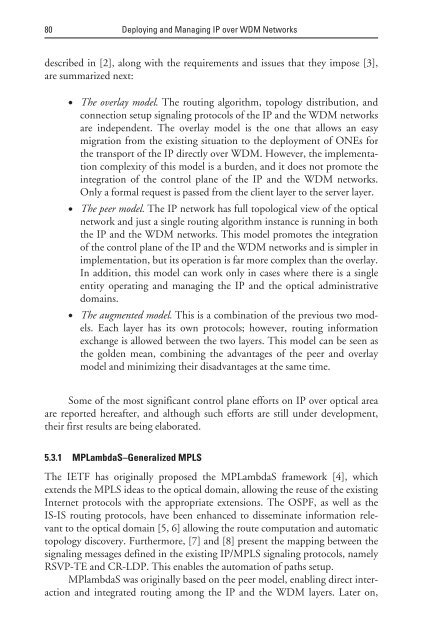deploying and managing ip over wdm networks - Index of
deploying and managing ip over wdm networks - Index of
deploying and managing ip over wdm networks - Index of
Create successful ePaper yourself
Turn your PDF publications into a flip-book with our unique Google optimized e-Paper software.
80 Deploying <strong>and</strong> Managing IP <strong>over</strong> WDM Networks<br />
described in [2], along with the requirements <strong>and</strong> issues that they impose [3],<br />
are summarized next:<br />
• The <strong>over</strong>lay model. The routing algorithm, topology distribution, <strong>and</strong><br />
connection setup signaling protocols <strong>of</strong> the IP <strong>and</strong> the WDM <strong>networks</strong><br />
are independent. The <strong>over</strong>lay model is the one that allows an easy<br />
migration from the existing situation to the deployment <strong>of</strong> ONEs for<br />
the transport <strong>of</strong> the IP directly <strong>over</strong> WDM. However, the implementation<br />
complexity <strong>of</strong> this model is a burden, <strong>and</strong> it does not promote the<br />
integration <strong>of</strong> the control plane <strong>of</strong> the IP <strong>and</strong> the WDM <strong>networks</strong>.<br />
Only a formal request is passed from the client layer to the server layer.<br />
• The peer model. The IP network has full topological view <strong>of</strong> the optical<br />
network <strong>and</strong> just a single routing algorithm instance is running in both<br />
the IP <strong>and</strong> the WDM <strong>networks</strong>. This model promotes the integration<br />
<strong>of</strong> the control plane <strong>of</strong> the IP <strong>and</strong> the WDM <strong>networks</strong> <strong>and</strong> is simpler in<br />
implementation, but its operation is far more complex than the <strong>over</strong>lay.<br />
In addition, this model can work only in cases where there is a single<br />
entity operating <strong>and</strong> <strong>managing</strong> the IP <strong>and</strong> the optical administrative<br />
domains.<br />
• The augmented model. This is a combination <strong>of</strong> the previous two models.<br />
Each layer has its own protocols; however, routing information<br />
exchange is allowed between the two layers. This model can be seen as<br />
the golden mean, combining the advantages <strong>of</strong> the peer <strong>and</strong> <strong>over</strong>lay<br />
model <strong>and</strong> minimizing their disadvantages at the same time.<br />
Some <strong>of</strong> the most significant control plane efforts on IP <strong>over</strong> optical area<br />
are reported hereafter, <strong>and</strong> although such efforts are still under development,<br />
their first results are being elaborated.<br />
5.3.1 MPLambdaS–Generalized MPLS<br />
The IETF has originally proposed the MPLambdaS framework [4], which<br />
extends the MPLS ideas to the optical domain, allowing the reuse <strong>of</strong> the existing<br />
Internet protocols with the appropriate extensions. The OSPF, as well as the<br />
IS-IS routing protocols, have been enhanced to disseminate information relevant<br />
to the optical domain [5, 6] allowing the route computation <strong>and</strong> automatic<br />
topology disc<strong>over</strong>y. Furthermore, [7] <strong>and</strong> [8] present the mapping between the<br />
signaling messages defined in the existing IP/MPLS signaling protocols, namely<br />
RSVP-TE <strong>and</strong> CR-LDP. This enables the automation <strong>of</strong> paths setup.<br />
MPlambdaS was originally based on the peer model, enabling direct interaction<br />
<strong>and</strong> integrated routing among the IP <strong>and</strong> the WDM layers. Later on,


